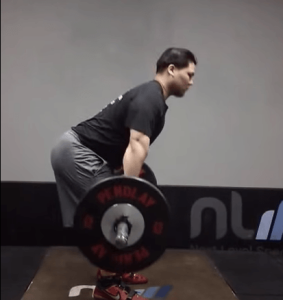The deadlift works the largest and strongest muscle in the human body – the gluteus maximus. A weakness in the glutes may result in a failure to reach goals and even injuries. While this muscle is working, it is being supported synergistically by many other muscles in the hips, back, and abdominals making it an excellent total body move and core strengthener.
When I Didn’t Deadlift
When I started weight training at age 20, I did not include deadlifts, but did barbell squats because I had learned that it was the greatest growth-stimulating exercise. However, when I was able to squat 100 lbs. with a barbell, I started having lower back pain. In my disappointment and uncertainty on how to resolve the issue, I resorted to using hack squats, holding the bar behind my hips and going only halfway down.
Yet I still managed to gain lean body weight, going from 130 to 155 lbs in the following five years. But beyond that point, I stopped gaining. Therefore, I tried doing partial squats with a low bar position behind my shoulders. I brought the tops of my thighs down to a level just short of parallel with the floor. Gradually, I successfully progressed enough to squat 400 lbs for sets of ten repetitions. However, not only did I still experience some back pain, but I also did not gain a single pound.
 Due Deadlift Diligence
Due Deadlift Diligence
When I designed a program for athletes at the high school where I taught, I added deadlifts and “Roman chair” sit-ups to my total-body program. I decided that if I demanded that the athletes do every exercise, I’ve got to set the example as they observe me training with them and do them as well. It was then that the whole world of training changed for me.
Suddenly, I could do full-depth (below parallel) back squats without pain. I assumed that the reason was that the Roman chair,
which strengthened the abdominals, build up additional strength to support my back. I then gained a solid 10 lbs. of muscle in the months that followed, which increased my leg size and even my upper body strength and size in a short period of time.
My max bench press increased by nearly 50 lbs. I was squatting with 225 lbs. for ten reps and could feel the back of my thighs squeeze against my calves – with no back pain! After about a year, I was full-depth, barbell squatting with 325 lbs. and accomplished a 405 lb. squat in a powerlifting competition.
At age 50, I changed my priorities and decided to eliminate the “hateful” deadlifts because I was no longer interested in feats of strength but rather more concerned about fitness and cardiac health. I continued with full squats, pressing/pulling movements and Roman chair sit-ups.
A couple of years later, I began having lower back pain again– slightly at first, but it progressively worsened over the years. I tried stretching, which helped some, but I reasoned that joint pain was the inevitable result of old age. I was still puzzled as to why the sit-ups no longer kept the back pain at bay.
Mystery Solved?
Maybe it wasn’t the sit-ups? Possibly it was the deadlifts that strengthened the lower back that enabled me to do the full-depth squats without pain years ago. I added deadlifts to my program again but adopted the “Romanian” style, going no lower than
touching the bar below the knee caps and doing sets of high repetitions with lighter weight.
Currently, I’m using 165 lbs. for 25 reps. My back pain is improving each time I increase the weight and stretch immediately after.
I should never have stopped doing deadlifts! They just may be the ideal movement, when performed properly, will improve core strength and protect the back from weakness and pain.
Guest Author Gary Knepper is an NFPT certified Advanced Strength Training Specialist and an Advanced Endurance Training Specialist.
Guest authors offer experience and educational insights based on their specific area of expertise. These authors are contributing writers for the NFPT blog because they have valuable information to share with NFPT-CPTs and the fitness community at-large. If you are interested in contributing to the NFPT blog as a guest, please send us a note expressing your interest and tell us how you can contribute valuable insights to our readers. We look forward to hearing from you! Send to editor@nfpt.com


